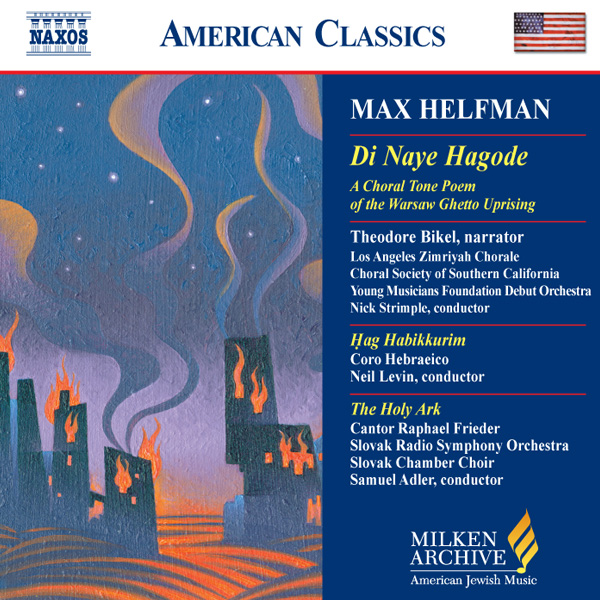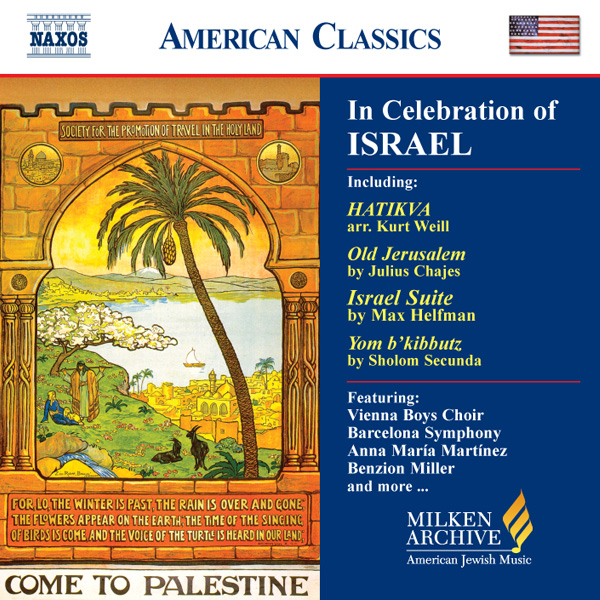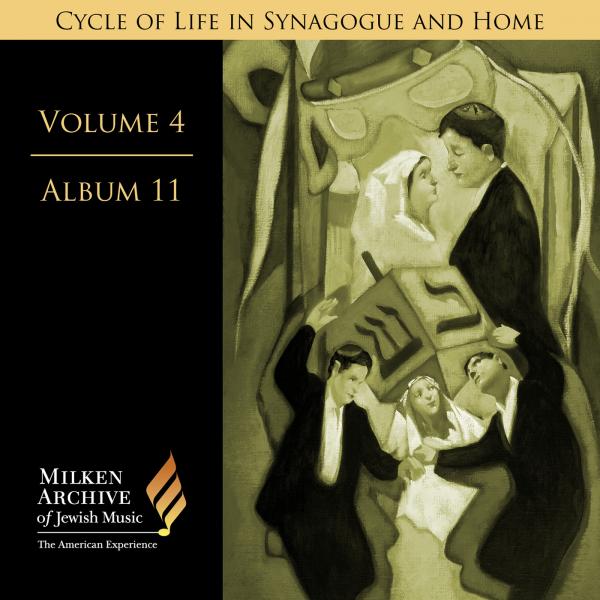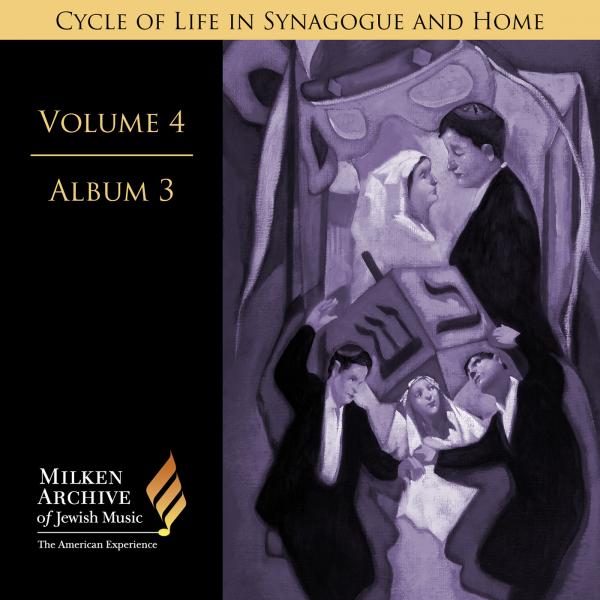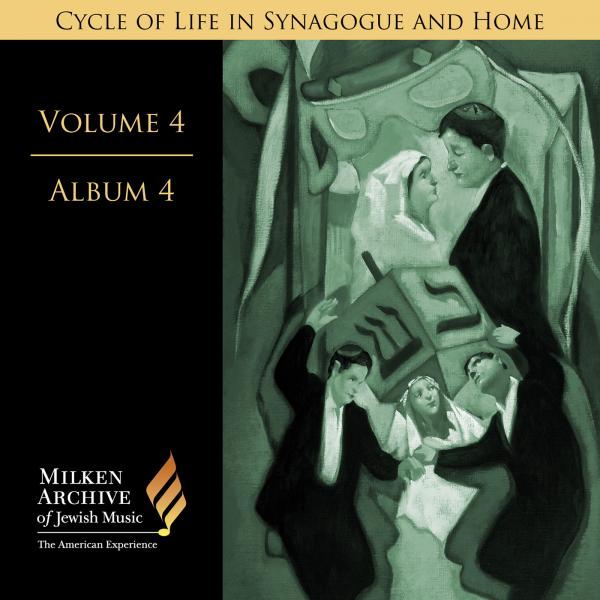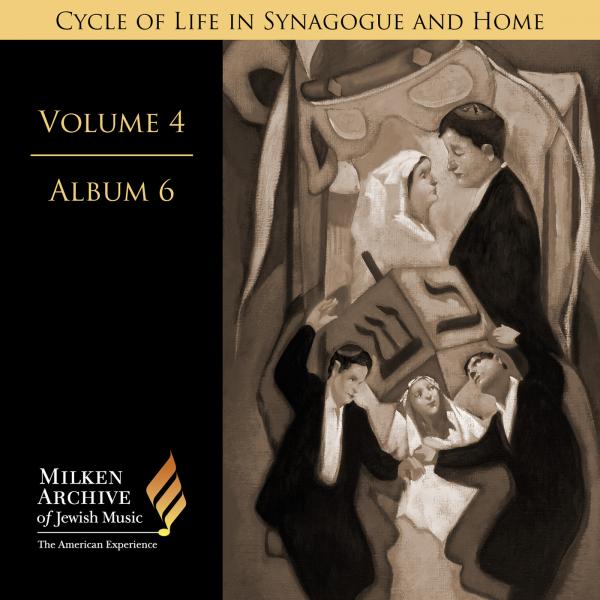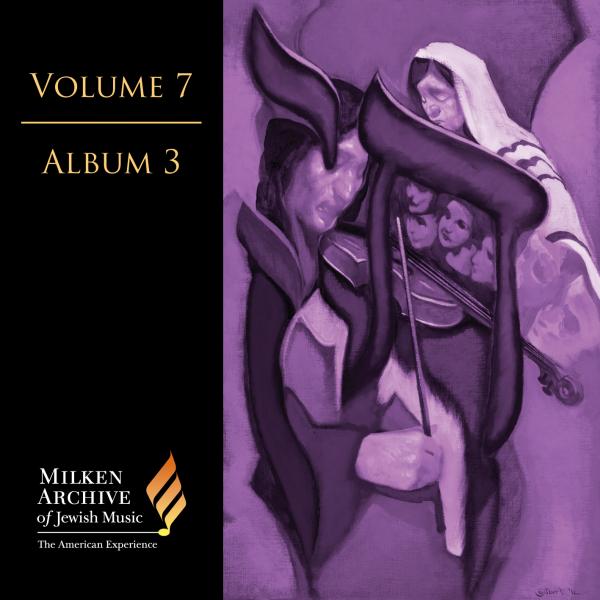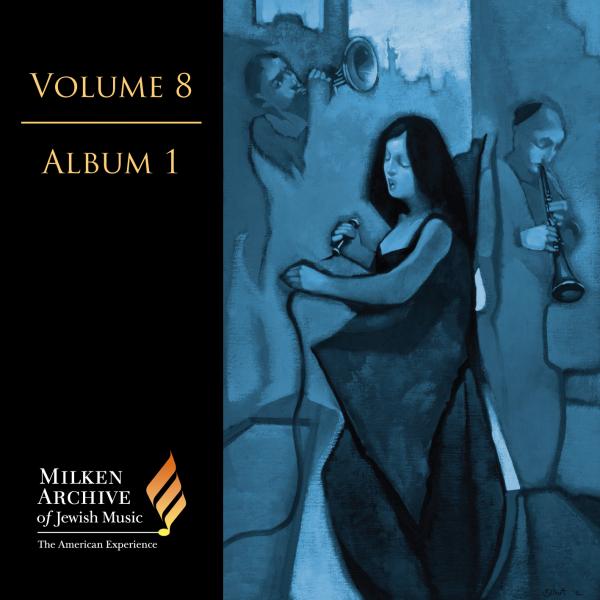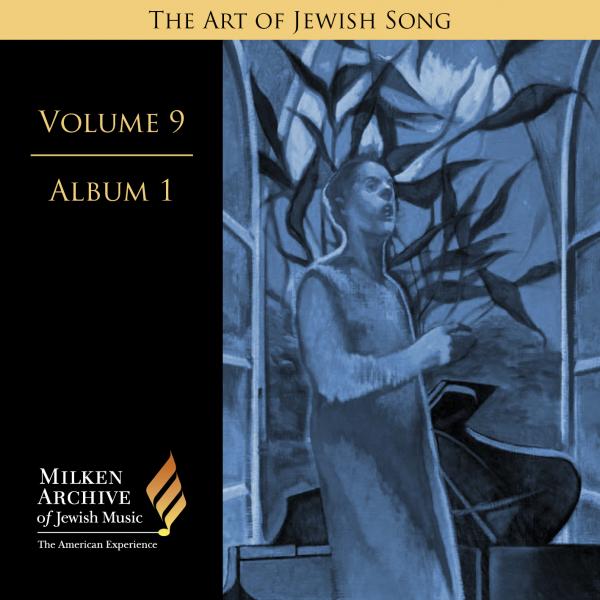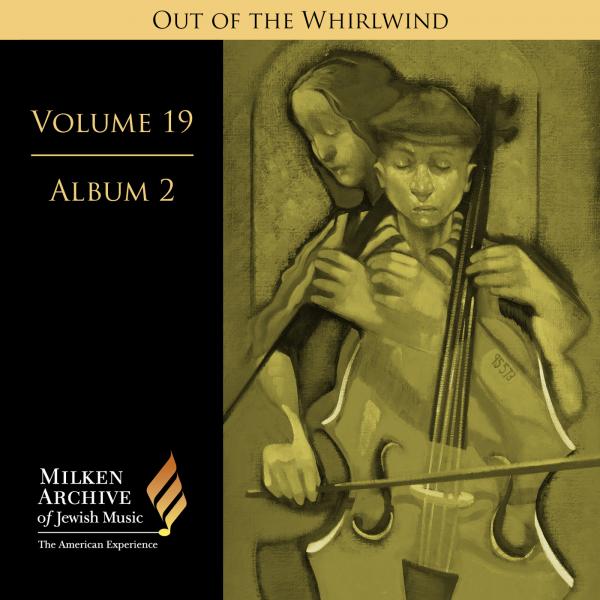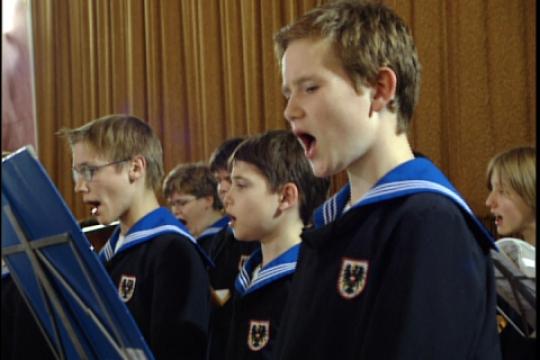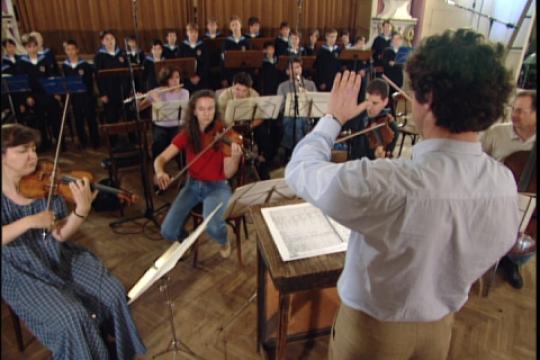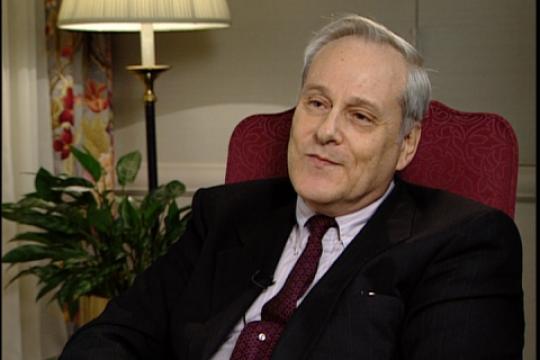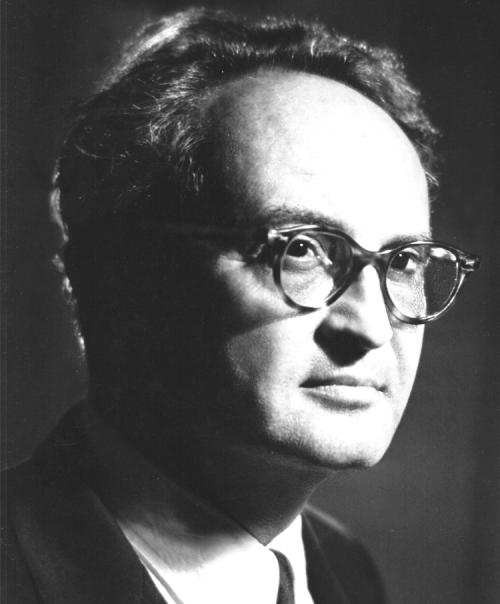
Composer, choral conductor, and educator Max Helfman was born in Radzin (Radzyn), Poland, where his father was a local teacher and cantor in whose choir he sang as a child. He arrived in America at the age of eight and soon became a sought-after boy alto in New York orthodox synagogue choirs. At the Rabbi Jacob Joseph Yeshiva school on New York’s Lower East Side, he acquired a traditional religious education, but little else is known about his childhood or teen years other than that his musical gifts became ever more apparent. He began experimenting with choral conducting and even composition on his own, and eventually he studied at the Mannes College of Music. Although he never had a formal university education, Helfman became a self-taught intellectual, familiar with the canon of both secular Jewish and Western literature and philosophy.
By 1928, he was offered a position as organist and choirmaster at Temple Israel in uptown Manhattan, succeeding the learned conductor and composer Zavel Zilberts. Helfman had no organ training, but he quickly acquired that skill through private lessons. At that time he began his long association with the temple’s cantor, David Putterman, for whom he began composing and arranging special settings. When Putterman left soon afterward to become the cantor of the Park Avenue Synagogue, Helfman accepted a position as choir director at Temple Emanuel in Paterson, New Jersey, where he organized an amateur choir that eventually grew into a respected and well- known concert chorus in addition to a liturgical choir for services. He held that post until 1940.
When he was twenty eight, he was awarded a three-year fellowship at the Curtis Institute in Philadelphia, where he studied piano with Ralph Leopold, composition with Rosario Scalero, and conducting with Fritz Reiner. He also became music director of the Paterson branch choir of the Arbeter Ring (Workmen’s Circle). Its repertoire then consisted almost entirely of nonreligious Yiddish songs, often related to that organization’s social action agenda and working people’s orientation (yet still fundamentally American). This musical niche constituted one important part of Helfman’s work for the remainder of his East Coast career. But the variety of his choral activities from that point on suggests either a true diversity in his choral interests and a catholicity of tastes or, conversely, an evolution in his own orientation.
Until his permanent relocation on the West Coast, in 1952, he was also actively involved with religious music, conducting sophisticated Reform High Holy Day services at the Washington Hebrew Congregation; at a traditional Conservative synagogue with the famous virtuoso cantor David Roitman; at many of the Park Avenue Synagogue’s special annual services of new music; and, beginning in 1940, for the chorus and music program at Newark’s prestigious B’nai Abraham, where he found it fulfilling to work with Abraham Shapiro, an important cantor of the time, and with that synagogue’s esteemed scholar, author, and rabbi, Joachim Prinz, who had been one of Berlin’s leading rabbinical personalities. From the late 1930s on, he turned much of his attention to new settings for Sabbath, High Holy Day, and Festival liturgies, as well as for other services. His choral pantomime Benjamin the Third, based on a story by the famous Yiddish author Mendele Moykher Sforim, was premiered at Carnegie Hall in 1938, as was his complete Sabbath service, Shabbat Kodesh (Holy Sabbath) in 1942. For a two-year period he also directed the Handel Choir of Westfield, New York, where he concentrated on classical—especially Baroque—repertoire.
Still, no consideration of Helfman can ignore his involvement as director of New York’s largest unabashedly leftist Yiddish chorus, the Freiheits Gezang Verein, which he took over in 1937 and which combined with some smaller choral groups of similar ideological sympathies to form the Jewish People’s Philharmonic Chorus. Founded as a worker’s chorus in the 1920s by Jacob Schaefer following his initial establishment of a similar chorus in Chicago (accounts and dates vary), its internal orientation and its acknowledged public persona were “left-wing Yiddishist” at the minimum—far to the left of the more benignly socialist organizations such as the Workmen’s Circle or the Labor-Zionist Farband and their choruses. The Jewish People’s Philharmonic Chorus was loosely federated under the national umbrella of the Jewish Workers Musical Alliance, which included Freiheits Gezang Verein affiliates in nearly thirty cities, directed by such conductors as Paul Held, Eugene Malek, Vladimir Heifetz, and Mendy Schein.
By the end of the 20th century, many of the aging alumni of Freiheits choruses from that era (at least through the 1950s) often preferred to remember them as “humanistically” oriented groups of “the folk.” But in fact they were commonly, if informally, known all during that period as the “communist Yiddish choruses,” or at least communist-leaning—labels they made no particular effort to reject or protest. That phenomenon must be understood in the context of the times, which involved general working-class concerns, utopian sentiments, and, especially during the 1930s, simply antifascism—but not necessarily political or ideological anti-Americanism or even anticapitalism. For some, the interjection “people’s” in the name was indeed a euphemism for actual communist sympathy, as it was in the world generally, whether naïvely or consciously deliberated. For others it simply signified a “folk chorus” whose repertoire was folk theme, folk literature, and folksong based.
What that “communist/leftist” identification actually meant—the degree to which those choruses actually represented political or party commitment—poses a complicated question that has yet to be studied on a scholarly plane. On one level, naïve embrace even of the Soviet Union as a “new order” and especially as the bulwark against the Fascists was certainly evident in some of the programmed concert selections. But no one has ever ascertained the actual voting patterns of the choristers. It is entirely possible that for many chorus members it was more a kind of cultural communism on an emotional plane than a political commitment that attracted them.
Nor is there any way to know Helfman’s motivation behind his directorship of the Freiheits chorus—to what extent it reveals any particular sympathies, or to what extent it represented anything more than a job and another good choral opportunity. At the time, it was considered a fairly prestigious position in New York circles, one held previously by no less an artist than Lazar Weiner. Jacob Schaefer too had been well respected musically, despite whatever political leanings he may have had. Nonetheless, the association did unfairly color some people’s views of Helfman and his music for a number of years, at least until he more or less shelved not only the chorus but most of his Yiddishist interests in favor of Zionist and Hebrew cultural perspectives.
In 1938, a year after he assumed directorship of the Freiheits chorus, Helfman also became the head of the Jewish Workers Musical Alliance. In that capacity he supervised the work of other affiliated choruses, as well as the Alliance’s music publication department, which issued choral arrangements of Yiddish folk and workers' songs and other settings in folio form as well as various compilations. Between 1937 and 1940, he published serially his own compilation, Gezang un kamf (Song and Struggle), which included choral arrangements of labor movement songs, songs of international proletarian class struggle, popular folksongs, and even some militant curiosities, all of which reflected the concert repertoire of the Freiheits chorus.
In 1945 the Histadrut Ivrit of America and the American Zionist Youth Commission established a Jewish Arts Committee to promote Zionist/Palestinian–oriented Hebrew culture and arts in the New York area. Its underlying goals were to mobilize, stimulate, and effect an ongoing dialogue with artistic life in Jewish Palestine, to attract American Jewish youth to Zionist ideals through the medium of artistic expression, and to establish ties between the two communities. Helfman was appointed the Arts Committee’s artistic director, working closely with its chairman, Rabbi Moshe Davis, and conducting yet a new choral ensemble, the Hebrew Arts Singers.
This new youth-targeted chorus and the Arts Committee’s focus on a Hebrew national cultural expression and the nationalist perspectives associated with Zionism were fundamentally different from the worldview articulated in much of the Freiheits choral music, and from its Yiddish idiom. For Helfman, this new endeavor marked the beginning of a different artistic as well as pedagogic direction, one that was to culminate in his most significant overall contribution.
That Jewish Arts Committee experience brought Helfman into contact with the profound idealist and educator Shlomo Bardin, the executive director of the American Zionist Youth Commission. The relationship was to have far-reaching consequences for Helfman. Bardin had emigrated to Palestine from the Ukraine in 1919 and had come to the United States to study at Columbia University. There, he made the acquaintance of Supreme Court Justice Louis Brandeis, who was known for his deep concern about Jewish youth and university-age students and their alienation from Judaism, partly as an unavoidable consequence of the appropriate freedom of the university experience. The challenge as Brandeis saw it was to find a way to make Judaism meaningful to this new American generation while in no way detracting from its full participation in American society and culture. A similar challenge had faced an earlier German Jewry as it sought to reconcile Jewish life and identity with modernity, not always with satisfactory results.
The Zionist example and its accompanying optimistic and youthful spirit offered a potential creative antidote to that feared disaffection. This struck a chord in Bardin, though he returned to Palestine and founded the Technical High School in Haifa (part of the Technion). But when he was unable to return home to Palestine from a second visit to the United States, in 1939, Brandeis inspired him to establish a cooperative-type institute based on the cultural aura and idealistic spirit of the kibbutz, also incorporating some elements of a Danish Folk High School that Bardin had witnessed. His first step was to seek a highly competent faculty that was committed to Jewish consciousness and was also gifted with the ability to inspire a genuine desire for Jewish identification. Reinforced in his instinct by Cantor Putterman’s recommendation, Bardin engaged Helfman to be the music director.
The Yiddish musical idiom was relevant neither to the goals nor the student makeup of the Brandeis Camp. Instead, the musical program there was to relate to the new and exciting endeavor in Palestine (and soon Israel)—music evoking the return to an ancient homeland, and songs about building the new society. This reoriented Helfman’s entire attitude and focus. For him, the music of Jewish identity shifted from songs of Jewish proletarian class struggle to the music of Israel, of Zionism, and of the new land. Much of his creative effort from then on was devoted to composing and arranging according to a Near Eastern and Hebrew Palestinian melos.
Helfman began his work at the Brandeis Camp’s Winterdale, Pennsylvania, location. When the camp at Santa Susana, California, near Los Angeles (now American Jewish University), was established in 1947, he went there, and composer Robert Strassburg took over the Pennsylvania post. By then there were three camps, the third in Hendersonville, North Carolina. In 1951 the two eastern locations were closed, and the California camp became the focus of all energies. Although it offered and encouraged all the performing arts, the musical activities directed by Helfman constituted for many students the most enduring and memorable part—as recalled half a century later by many.
In Bardin, Helfman found an ideal partner and fellow advocate. “Music unites people,” Bardin proclaimed. “It is stronger than words.” What Helfman tried to create there was what he called a Jewish Renaissance through music, which he perceived as the ideal mediator between tradition and identity on one hand and rational modernity on the other. He underscored that view in many of his lectures:
Some think there is a wall between Jew and gentile; but the real wall is between the Jew and himself: the young Jew who has been running away from his heritage and in doing so has turned his back on a rich creative past.... They will argue with you—but you cannot argue with a song or with a dance.
Helfman conducted choirs and ensembles, inspiring enthusiastic participation with his infectious personality. He wrote and arranged secular music for the students; and he composed modern, youth-oriented prayer services, later issued as the Brandeis Sabbath Services. Through all these activities, the students became conversant with the rich musical atmosphere, dance expressions, and song repertoire of the yishuv—the Jewish settlement in British-mandate Palestine—and of modern Israel.
Almost immediately Helfman envisioned yet another project: a sort of “Jewish Interlochen,” or Jewish version of Tanglewood within the Brandeis framework, where artistically gifted Jewish college-age youth could be trained for leadership within the cultural life of American Jewry. Such an institute would create, provide, and disseminate programs and materials expressive of a Jewish ethos and would fulfill the cultural needs of the contemporary Jewish community. It would also provide a forum for established Israeli and other Jewish composers to share their knowledge and experience with young American artists. This project was aimed not at amateurs or general students, but at those between the ages of eighteen and twenty-five who were already technically accomplished young composers, writers, performers, conductors, and dancers.
Helfman’s and Bardin’s dreams thus came to pass with the establishment of the Brandeis Arts Institute, which opened in the summer of 1948 and was held for five consecutive summers concurrently with the regular Brandeis Camp. The distinguished resident-artist faculty for music included such major figures as Bracha Zefira, Mario Castelnuovo-Tedesco, Julius Chajes, Eric Zeisl, Heinrich Schalit, Alfred Sendrey, Izler Solomon, Ernst Toch, and many others. (Important figures from the worlds of dance, drama, and fine arts were also in residence.) Among the young composers who eventually became prominent contributors to American music, and for whom that experience was in many cases a turning point in their outlooks, were Yehudi Wyner, Jack Gottlieb, Charles Davidson, Gershon Kingsley, Raymond Smolover, and Charles Feldman.
The Brandeis Arts Institute lasted only through the summer of 1952, but Helfman directed the music program at the Brandeis Camp for seventeen years. During that time he influenced and inspired an entire generation of young people and sparked its awareness of the breadth of Jewish music. He continued to compose as well, for media apart from camp performances. His theatrical scores from that period include music for Itzik Manger’s new version of Abraham Goldfaden’s early Yiddish operetta Di kishefmakhern, and for The Rabbi and the Devil—an adaptation of a story by Isaac Leyb [Yitskhoh Leyb/Leybush] Peretz. He also collaborated with Ted Thomas on the Hanukka operetta It’s a Miracle, and on Purim Carnival, for which he wrote all the songs. He wrote a number of art songs, including Two Hannah Szenesh Poems, Spanish Serenade (poetry by Yuri Suhl), and Five Little Songs About God and Things—as well as songs for wedding ceremonies.
Helfman was not one of the most prolific composers, partly because he could never quite determine his own artistic priorities and partly because in many ways he was first and foremost a pedagogue who devoted his time and energy to his work with youth and to lecturing. He continually allowed his passion for choral organizing and conducting to take precedence over composing. Many of his pieces remain in manuscript; he even once remarked that his reason for leaving so many works unsubmitted to his publisher was simply that he could not take the time to write out clear copies. However, his estimable body of works—especially his synagogue music—reveals a carefully calculated use of classical techniques in a completely fresh-sounding guise, with a sense of polish and refinement. All his liturgical music has an absolute aura of originality, yet wherever appropriate, it contains references to traditional modes, motifs, and patterns. As an artist, he relied on these traditional elements as seeds, not as confinements. His own words on the subject are revealing: “Originality is the most important quality of a composer. It is not achieved by breaking with the past, but by building on it and using it as a foundation.” Nearly every one of Helfman’s liturgical works is a miniature masterpiece, and together they form one of the most significant contributions to the American Synagogue.
In 1954, the West Coast branch of Hebrew Union College—the College of Jewish Studies in Los Angeles—opened a department of sacred music, ostensibly for cantorial and cantor-educator training. Helfman was appointed to direct it, remaining until 1957, when Cantor William Sharlin replaced him. (The enrollment of matriculating students was always relatively small, and the program did not include ordination or investiture.) Helfman was also the music director during the 1950s at Sinai Temple in Los Angeles, one of the nation’s largest Conservative synagogues, where he frequently presented concerts of sacred music prior to services.
In 1958, he was invited to establish a department of fine arts at the University of Judaism in Los Angeles and to serve as its dean. He invited Robert Strassburg to serve as assistant dean, and together they devised an ambitious program with a faculty that included such distinguished artists as Castelnuovo-Tedesco, Benjamin Zemach, Sendrey, and Roy Harris, and such prominent guest lecturers as Lukas Foss and Roger Wagner. It was to have some connection to its parent institution, the Seminary College of Jewish Music at the Jewish Theological Seminary in New York, especially with regard to graduate degrees. Hugo Weisgall, chairman of the music faculty at the Seminary in New York, did have some correspondence with the University of Judaism concerning prospective graduate students and their projects, and in fact some serious work was accomplished. Cantor Philip Moddel’s valuable monograph on Joseph Achron, for example, began as his dissertation there. But the department never materialized on the level Helfman and Strassburg had envisioned.
Helfman kept no central repository of his own works and no reliable catalogue; nor did he even date most of his manuscripts. After his premature, sudden death at sixty-two, many of his unpublished compositions and sketches had to be collected from a number of sources—a process that remains uncompleted. To this day Helfman manuscripts are occasionally discovered in archives, although some were published posthumously in the late 1960s. Some of his works may be lost permanently. At first glance, Helfman represents a cluster of contradictions:
- Helfman the master liturgical composer whose pieces reveal the deepest nuances of prayers, yet who was not terribly religious in the traditional sense;
- Helfman the conductor of one of the most left-wing, antinational Yiddishist choruses and the arranger of songs extolling the passions of an international workers’ order, yet the champion of Zionist and Jewish nationalist and modern Hebrew culture;
- Helfman the advocate of Jewish identity for youth, yet Helfman the universalist.
Viewed in perspective, these were not contradictions, but the tensions that strengthened his art.
Composer Jack Gottlieb remembered him as “a Pied Piper; a Svengali—a shaper of men.” Rabbi William Kramer summed up the Helfman phenomenon: “Max was a happening, and he caused other people to happen.” Helfman’s biographer and student, Philip Moddel, carried it one step further: “Max Helfman was an American happening.”
By: Neil W. Levin
